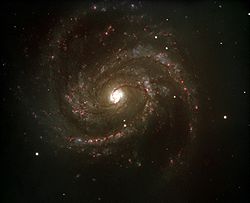Messier 100


Messier 100 (also known as NGC 4321) is an example of a so-called 'grand design' spiral galaxy.[1] It is visible in the southern part of constellation Coma Berenices. Messier 100 is one of the brightest and largest galaxies in the Virgo cluster, about 55 million light-years away, with a diameter of 160,000 light years.[2] It was discovered by Pierre Méchain in 1781. Later it was entered in Messier’s catalogue of nebulae and star clusters after Charles Messier made observations of his own a month later.[3][4] The galaxy was one of the first spirals discovered,[3] and was listed as one of 14 spiral nebulae by the Earl of Rosse in 1850.
The galaxy has two satellite galaxies, NGC 4323 – connected with M100 by a bridge of luminous matter – and NGC 4328.[5][6]
Star formation
Messier 100 is considered a starburst galaxy with a radius of 1 kilo-parsec, where star formation has been taking place for least 500 million years in separate bursts.[7] Star formation is concentrated in a ring – actually two tightly wound spiral arms attached to a small nuclear bar.[8][9]
As usual on spiral galaxies of the Virgo Cluster, in the rest of the disk both star formation and neutral hydrogen are reduced in the galaxy's disk, something caused by interactions in the Virgo cluster.[10]
Messier 100 Media
Supernova SN 2019ehk in M100 (Hubble)
Related pages
Other Grand design spiral galaxies
- Whirlpool galaxy-Another Grand design spiral galaxy
- Pinwheel galaxy-Another Grand design spiral galaxy
- Messier 74-Another Grand design spiral galaxy
- Messier 81-Another Grand design spiral galaxy
References
- ↑ "Messier 100". SEDS: Spiral Galaxy M100 (NGC 4321), type Sc, in Coma Berenices. Archived from the original on 2011-09-03. Retrieved 2010-02-23.
- ↑ "Messier100". Hearst Observatory. Retrieved 2010-02-23.
- ↑ 3.0 3.1 "Messier 100". SEDS: Observations and Descriptions. Archived from the original on 2011-06-24. Retrieved 2010-02-23.
- ↑ "Catalog of Nebulae and Star Clusters". SEDS. Archived from the original on 2000-12-03. Retrieved 2010-02-23.
- ↑ Lua error in Module:Citation/CS1/Identifiers at line 630: attempt to index field 'known_free_doi_registrants_t' (a nil value).
- ↑ "NGC 4323". SIMBAD. Retrieved 2010-02-23.
- ↑ Wozniak H.; et al. (1999). "Double-barred starburst galaxies viewed by ISOCAM". The Universe as Seen by ISO. 427: 989. Bibcode:1999ESASP.427..989W.
- ↑ Lua error in Module:Citation/CS1/Identifiers at line 630: attempt to index field 'known_free_doi_registrants_t' (a nil value).
- ↑ Lua error in Module:Citation/CS1/Identifiers at line 630: attempt to index field 'known_free_doi_registrants_t' (a nil value).
- ↑ Lua error in Module:Citation/CS1/Identifiers at line 630: attempt to index field 'known_free_doi_registrants_t' (a nil value).

